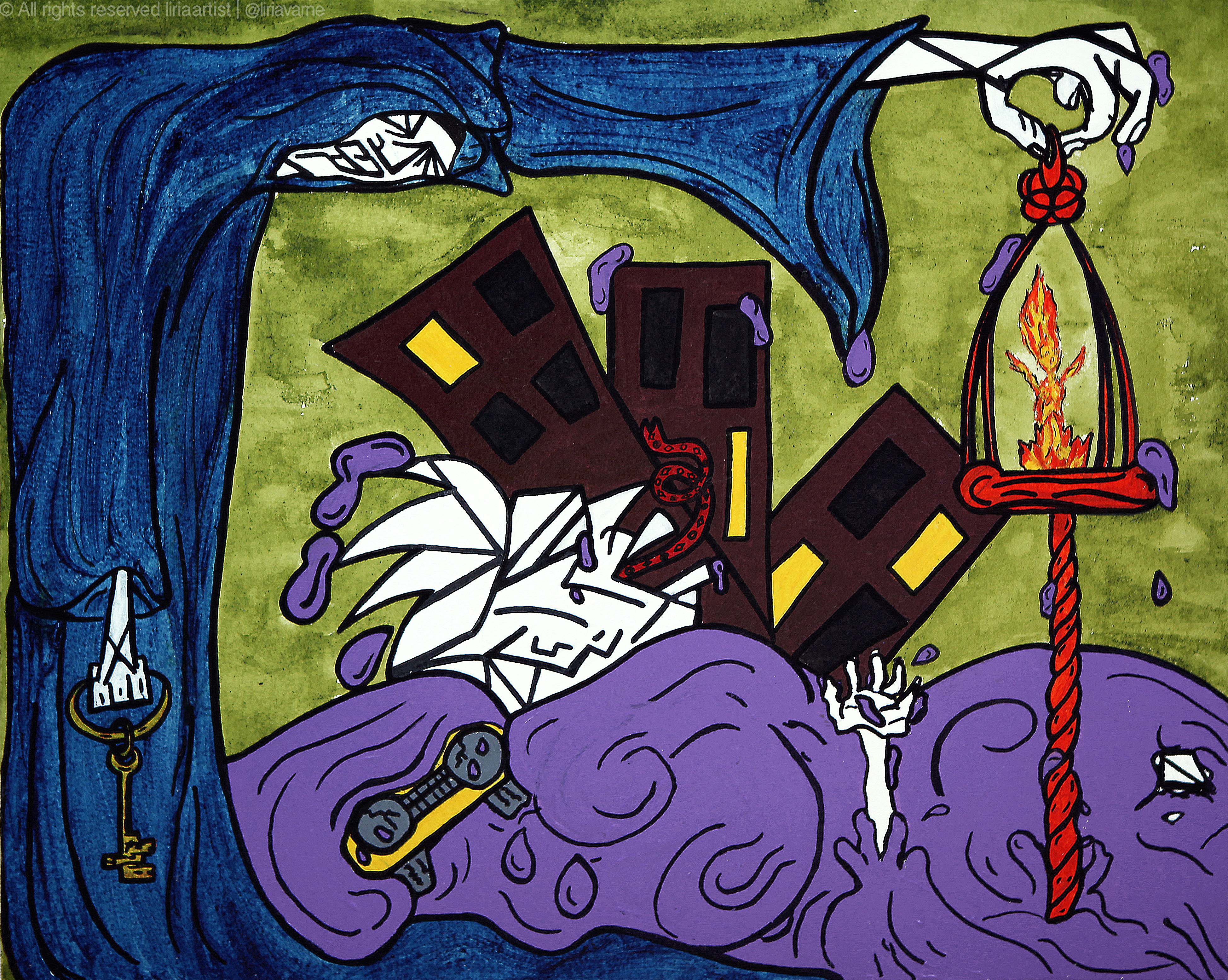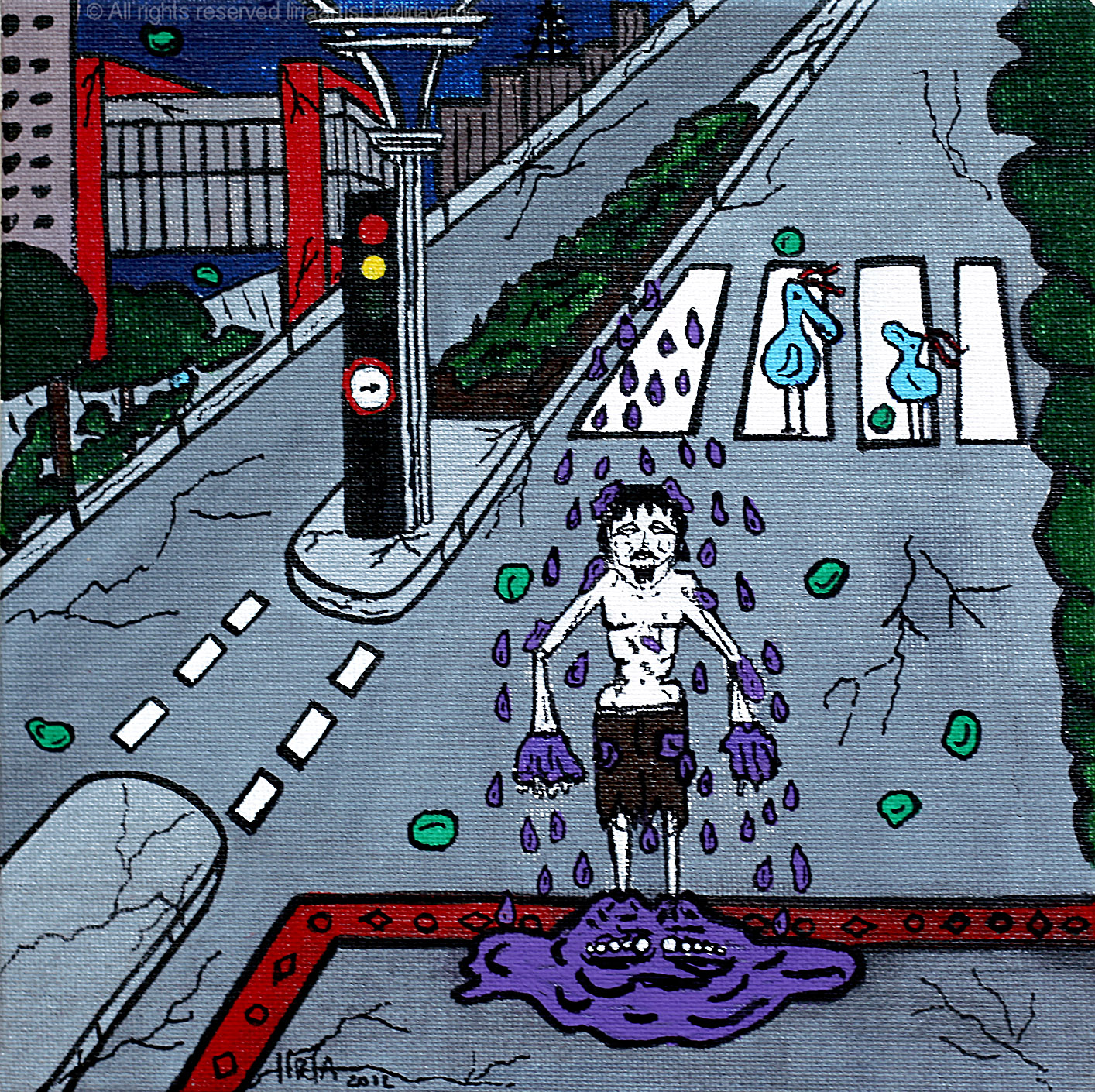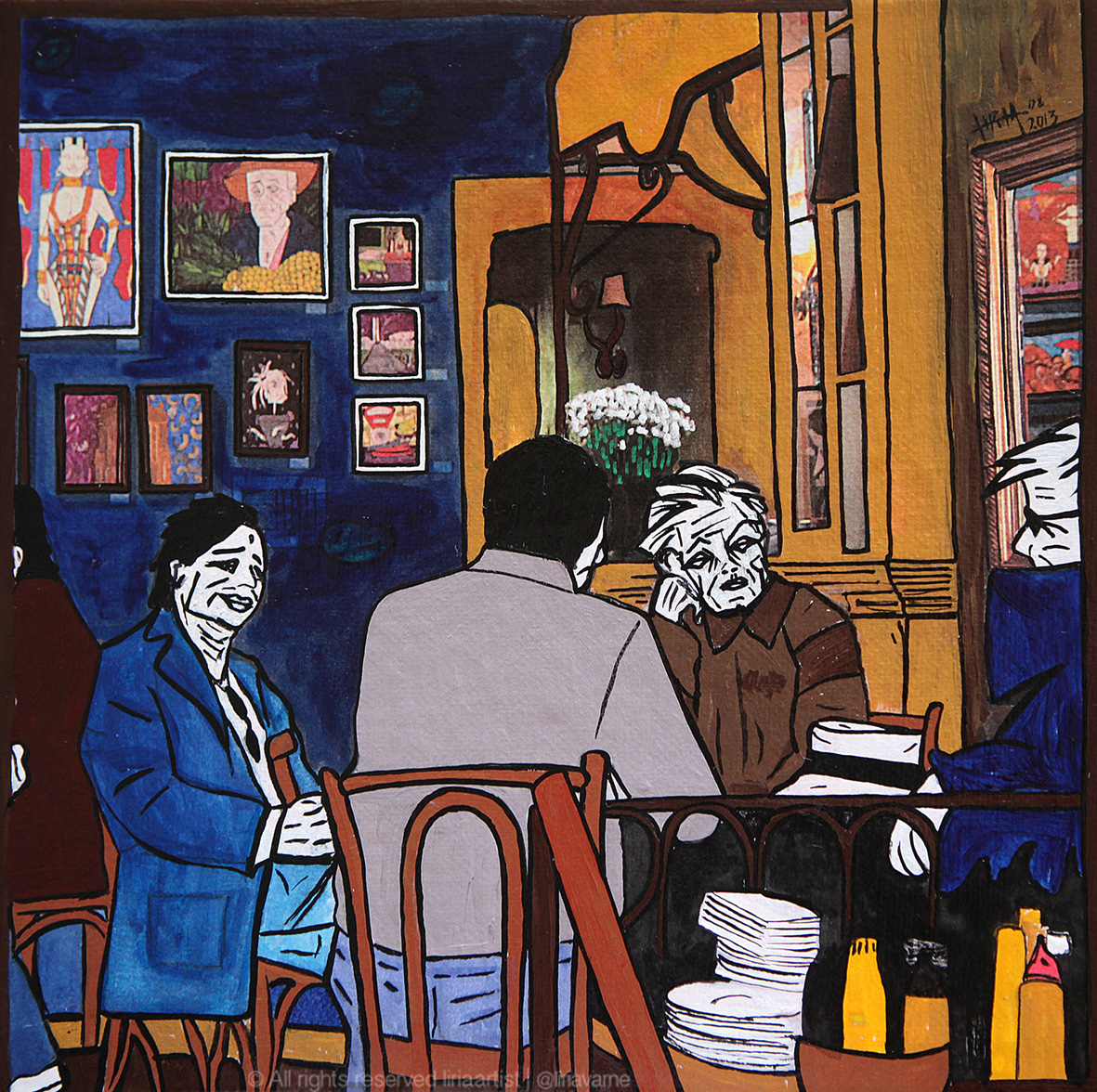The amazing world of Líria Varne
Claudio Castro Filho[1]

[Líria Varne, Subviver em São Paulo (Un-live in São Paulo), acrylics on canvas, 40 x 50 cm, 2012]
Heinrich Wölfflin[2] is known for having made one of the most impressive syntheses of the history of paintings, when revisiting the entire repertoire of what we may consider the European “pinacotheca” under the perspective of the dialectic ‘linear’ versus ‘painterly’. Arguing against the historical theories with sociological grounds, Wölfflin understood the style changes in history of art to be derived from the individual tendency shown by each artist in his own plastic aesthetics – if a group had the “line” as their main focus of painting, others made the color their identifying character. Being so, for instance, Dürer’s huge investment in drawing as the organizing element of his paintings would make him a “linear” artist, while Rembrandt – with his volumetric and atmospheric compositions – was to become a master of the pictorial.
If Wölfflin’s theory, still nowadays, may sound trendy, that is due to two main reasons: first, because it gives back to the artist a meaning for style, while understanding personal expression as part of an art trend; secondly, because it defines the very key-elements that constitute the materiality and the modus operandi of paintings. Then came the vanguards, as well as post-historical readings of western art, and with them the impossibility of understanding the artistic phenomenon in a close relation to contemporary styles; art rebels against academic programs and the very depiction of the world, choosing instead the disruption with tradition and an intervention on reality. Painter as Cézanne, Van Gogh, Picasso or, in the Brazilian context, Tarsila and Malfatti, all of them nonconformists, travel for different poetics; they explore the unusual and material use of color and provide the lines with overtones of metalanguage, since they use the latter as an identifying element of the painting’s truth.
After the death of the painting proclaimed by abstract expressionism, and the grief fulfilled by the many post-war conceptualisms, contemporary art is for at least three decades trying to reconcile with the oil on canvas technique. It is interesting to recognize how Brazil’s international repercussion in the world of arts, a position confirmed by a conceptual movement as it was neo-concretism, is being defined by the singularity of painters unreconciled with any kind of one-voice aesthetic speech. One might actually proclaim Brazilian paintings, nowadays, as living a remarkable nostalgia for the historical vanguards, since it seems to have been taking advantage of the stereotype of a country with no tradition to both absorb and cut with several possible traditions. It is in this very threshold between approaching and departing from traditional legacy that stands the work of the Paulistan painter Líria Varne.
In this reading on Líria Varne’s works, having begun with Wölfflin was no coincidence: the painting of the Paulistan actually sustains mostly in the exaggeration of her preferable two elements of art, drawing and color. Her aesthetic is, since the very beginning (around 1997), extremely labeled by a mostly graphic comprehension of the pictorial space. Being so, Líria Varne’s painting is specially an urban painting, as if transposing into the small scale of the canvas the very interventionist trace that we are use to recognize in street art. The dialogue with reality is thus labeled by an affective and cognitive cry yelled at the spectator. The graphic organization of the elements in Varne’s painting recalls for an immediate apprehension of its plastic message, suitable for contemporary eyes, very used to excessive visual challenge. Furthermore, as our eyes travel for the structural signature of a painting, new layers of readings keep being revealed, always marked by a strong poeticization of reality and an uncommon political regard on the everyday universe.

[Líria Varne, Chuva em São Paulo II (Rain at São Paulo II), acrylics on canvas board, 20 x 20 cm, 2012]
The figurative characteristic of her poetics puts her in an interesting threshold between graffiti and pop art; her nostalgia for the first vanguards – identifiable for instance by her exercise of the cubist trace and the expressionist use of color – deconstruct the picture according to new apprehensions of reality, in a constant tension between the self, the space and the world. The portrayed object detaches from reality in order to emphasize the two-dimensional truth of the canvas, giving birth to a remarkable distress between the character and the background, a truthful metaphor of the complete inadequacy of the self in his most immediate context. Therefore, the human character immediately reminds us of marginalized voices, all those staffed bodies and engraved expressions, in the context of a constant misfit between man and city. The urban space, summarized in the “crude concrete poetry” of an idealized São Paulo, is the stage for apparently bewildering characters, that yearn for leaving the suburb’s darkness and taking by assault their place in that other sphere, the one of power and touristic folklore. The series Chuva em São Paulo [Rain at São Paulo], two acrylics on canvas board dated from 2012 held at exhibition at the 2013’s edition of the QuadriArt, in Berlin, is a perfect example of that constant game between aesthetic experimentalism and the political complaint, characteristic of the painter’s most recent watch.
In a time when official artistic circuits once again accommodate peripheral aesthetics, Líria Varne’s view on the stereotypes of a doubtful brazilianity does not refuse the expression of a certain tropical exoticism, even if it is to subdue such a crystalized concept to a contentious critical riddle. Yet, the artist does not ignore the role of artistic iconography in the construction/subversion of speeches of a national aesthetic, and maybe that is why she keeps exploring other cornfields that may show the woven complexity of Brazilian contemporary art; that can also probably explain her own militancy on trusteeship, as in the case of the Brazylian group of art of the Kunstmesse, held in September 2013 at the Postbanhof of Berlin, nowadays an international reference when it comes to independent exhibitions.

[Líria Varne, Dankeschön, from the series Coisas incríveis acontecem (Amazing things happen), mixed technique on canvas board, 20 x 20 cm, 2013]
Even so, that insoluble dialectics between the local and the universal still adjusts to the cosmopolitan dimension of her plastic creations. The domestic scale of some of her most recent works, once again in the scale of 20x20cm canvas board, seems to add the graphics of painted tiles to the pallet of her aesthetic references. Furthermore, her research on the possibilities of a support labeled by moderation and symmetry immediately provides her an instantaneous yet fragmentary scope on the reality, giving the painting a sort of immediate theatricality. Such is the case of the irreproachable Dankeschön, from the series Coisas incríveis acontecem (Amazing things happen), also from the latter harvest.
A last paradigmatic example of Varne’s poetics is evident is Subviver em São Paulo (Un-live in São Paulo), from 2012, an acrylic on canvas held at the Autumn Latin-American Saloon that took place in the Alliance Française of São Paulo in May 2013. The aforementioned conflict between reality and imaginary, as well as between the self and the world, turns Líria Varne’s paintings into a crystal-clear and amazing universe that, in spite of its rough speech, captivates the spectator by inviting him into the meadows of a strange fairy-tale kind of reality. A reality that unveils, in its very plastic expression, what the hacking of the days keeps willing to silence.
[Granada, December 2013]
.
.
.
.
[1] Postdoctoral researcher in the UI&D Centro de Estudos Clássicos e Humanísticos from the University of Coimbra (area of Art Semantics and Pragmatics), and collaborator at the post graduation Program of Literary and Art Theory (University of Granada).
[2] Apud Wölfflin, H. “Sobre o linear e o pictórico”, em: ________. Conceitos fundamentais de história da arte [trad. João Azenha Júnior]. São Paulo: Martins Fontes, 1996.